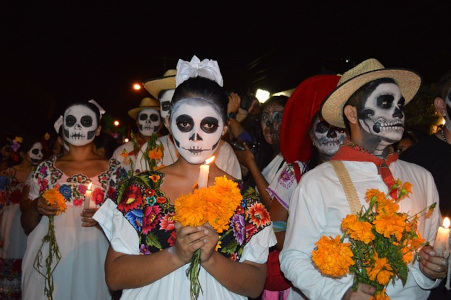“The life of the dead is placed in the memory of the living”. Have you ever seen pictures of colourful skulls decorated with pretty flowers? And did you know that they are connected to a three-day festival held in the fall? If you are interested in finding out more about this beautiful holiday celebrating life, then keep reading!

Dia de las Brujas
Dia de las Brujas or the “Day of the Witches” is celebrated every year on October 31st and it’s, as you probably know it, just like Halloween. In some parts of Spain, the people dress up in costumes and parade through the city, whereas in other parts pumpkins are being caved and parties being held around a bonfire. The kids of many Spanish-speaking countries dress up and go trick-or-treating with the saying “We want Halloween” (Queremos Halloween).
Dia de Todos los Santos
The 1st of November is All Saints Day. It is dedicated to saints and passed loved ones where flowers are being brought to the graves. It is also known as the Dia de los Muertos chiquitos and its believed that the gates to heaven open at midnight on the 31st and that deceased children can return to their families for 24 hours.
Dia de los Muertos/Difuntos
The Day of the Dead is traditionally celebrated on the 2nd of November and is all about the celebration of life. Just like with the deceased children, on the Dia de los Muertos, the dead adults return to their homes and celebrate with their loved ones. The emphasis of these days lies on remembering and not forgetting about their death.

Traditions and decorations
Most of the decorations around the Day of the Dead can be found in the homes of the families. There, altars are often set up and decorated with things that help the soul find their way back to the living. Often included are pictures of the deceased, objects that belonged to them, water, bread, candles and the traditional Day of the Dead flower marigolds. Popular in Mexico, and especially Mexico City, are the Day of the Dead parades. The streets are filled with big skeletons, costumes, music and dancers and it is watched by numerous inhabitants and tourists. You have probably seen pictures of people attending these parades covered in faint paint representing skeletons.
Spain vs. Mexico
While the days around the beginning of November date back to the same origin, they are not celebrated in the same way. The Dia de los Muertos is not an official holiday in Spain anymore and is more likely to be combined with All Saints Day. Even though the day is not celebrated as big as in Mexico, families still gather at the cemeteries to lay flowers at the graves of their passed loved ones.
If you ever find yourself in a Spanish-speaking country, or one of the numerous other countries that celebrate the Day of the Dead, around the beginning of November, then make sure to check out the parades held in the city and experience this holiday first-hand!
Sources:
https://www.history.com/topics/halloween/day-of-the-dead
https://entrelenguas.com/halloween-in-spain/
https://baselang.com/blog/travel/day-of-the-dead-in-spanish/
https://murphyswitchwalk.com/press-room/f/spanish-halloween-history-dia-de-las-brujas-day-of-the-dead#:~:text=It%20is%20when%20Spanish%20people,their%20deceased%20relatives%20and%20friends
https://vickiviaja.com/spain-day-of-the-dead-dia-de-los-muertos/

